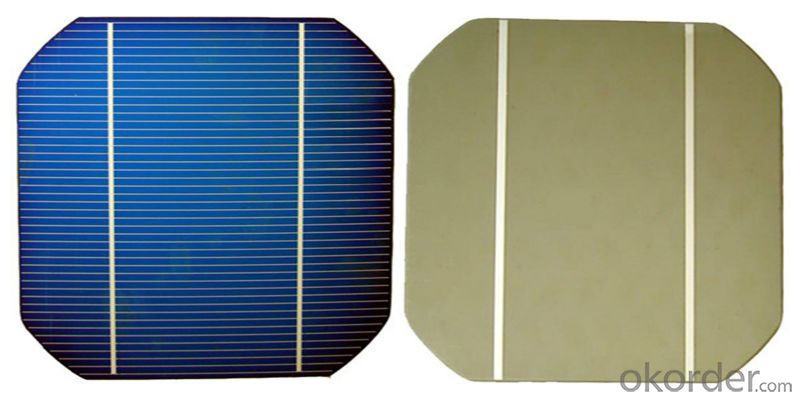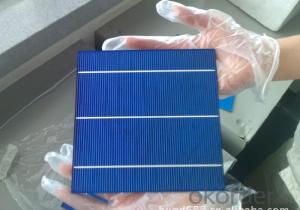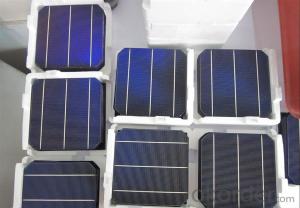Solar Silicon Wafer Price - High Quality A Grade Polycrystalline 5V 16.0% Solar Cell
- Loading Port:
- Shanghai
- Payment Terms:
- TT OR LC
- Min Order Qty:
- 1000 pc
- Supply Capability:
- 100000 pc/month
OKorder Service Pledge
OKorder Financial Service
You Might Also Like
Specifications
hot sale solar cell
1.16.8%~18.25% high efficiency
2.100% checked quality
3.ISO9001/ISO14001/TUV/CE/UL
4.stable performance
We can offer you the best quality products and services, don't miss !
POLY6'(156*156)
Polycrystalline Silicon Solar cell
Physical Characteristics
Dimension: 156mm×156mm±0.5mm
Diagonal: 220mm±0.5mm
Thickness(Si): 200±20 μm
Front(-) Back(+)
Blue anti-reflecting coating (silicon nitride); Aluminum back surface field;
1.5mm wide bus bars; 2.0mm wide soldering pads;
Distance between bus bars: 51mm . Distance between bus bars :51mm .
Electrical Characteristics
Efficiency(%) | 18.00 | 17.80 | 17.60 | 17.40 | 17.20 | 16.80 | 16.60 | 16.40 | 16.20 | 16.00 | 15.80 | 15.60 |
Pmpp(W) | 4.33 | 4.29 | 4.24 | 4.19 | 4.14 | 4.09 | 4.04 | 3.99 | 3.94 | 3.90 | 3.86 | 3.82 |
Umpp(V) | 0.530 | 0.527 | 0.524 | 0.521 | 0.518 | 0.516 | 0.514 | 0.511 | 0.509 | 0.506 | 0.503 | 0.501 |
Impp(A) | 8.159 | 8.126 | 8.081 | 8.035 | 7.990 | 7.938 | 7.876 | 7.813 | 7.754 | 7.698 | 7.642 | 7.586 |
Uoc(V) | 0.633 | 0.631 | 0.628 | 0.625 | 0.623 | 0.620 | 0.618 | 0.617 | 0.615 | 0.613 | 0.611 | 0.609 |
Isc(A) | 8.709 | 8.677 | 8.629 | 8.578 | 8.531 | 8.478 | 8.419 | 8.356 | 8.289 | 8.220 | 8.151 | 8.083 |

MONO5'(125*125mm)165
Monocrystalline silicon solar cell
Physical Characteristics
Dimension: 125mm×125mm±0.5mm
Diagonal: 165mm±0.5mm
Thickness(Si): 200±20 μm
Front(-) Back(+)
Blue anti-reflecting coating(silicon nitride); Aluminum back surface field;
1.6mmwide bus bars; 2.5mm wide soldering pads;
Distance between bus bars: 61mm . Distance between bus bars :61mm .
Electrical Characteristics
Efficiency(%) | 19.40 | 19.20 | 19.00 | 18.80 | 18.60 | 18.40 | 18.20 | 18.00 | 17.80 | 17.60 | 17.40 | 17.20 |
Pmpp(W) | 2.97 | 2.94 | 2.91 | 2.88 | 2.85 | 2.82 | 2.79 | 2.76 | 2.73 | 2.70 | 2.67 | 2.62 |
Umpp(V) | 0.537 | 0.535 | 0.533 | 0.531 | 0.527 | 0.524 | 0.521 | 0.518 | 0.516 | 0.515 | 0.513 | 0.509 |
Impp(A) | 5.531 | 5.495 | 5.460 | 5.424 | 5.408 | 5.382 | 5.355 | 5.328 | 5.291 | 5.243 | 5.195 | 4.147 |
Uoc(V) | 0.637 | 0.637 | 0.636 | 0.635 | 0.633 | 0.630 | 0.629 | 0.629 | 0.628 | 0.626 | 0.626 | 0.625 |
Isc(A) | 5.888 | 5.876 | 5.862 | 5.848 | 5.839 | 5.826 | 5.809 | 5.791 | 5.779 | 5.756 | 5.293 | 5.144 |

FAQ:
Q:How can i get some sample?
A:Yes , if you want order ,sample is not a problem.
Q:How about your solar panel efficency?
A: Our product efficency around 17.25%~18.25%.
Q:What’s the certificate you have got?
A: we have overall product certificate of ISO9001/ISO14001/CE/TUV/UL
- Q: What is the purpose of an encapsulant in a solar silicon wafer?
- The purpose of an encapsulant in a solar silicon wafer is to protect the wafer from moisture, dust, and other environmental factors, ensuring its long-term durability and performance. It also helps to enhance the efficiency of the solar cell by minimizing reflection and providing a smooth surface for better light absorption.
- Q: Can solar silicon wafers be used in solar-powered water pumps?
- Yes, solar silicon wafers can be used in solar-powered water pumps. The wafers are used to convert sunlight into electricity, which can then be used to power the water pump.
- Q: How do solar silicon wafers perform in high humidity conditions?
- Solar silicon wafers generally perform well in high humidity conditions. However, excessive moisture can potentially affect their performance and efficiency by causing corrosion or oxidation of the surfaces. Therefore, it is important to ensure proper sealing and protection of the wafers to mitigate any negative impact of high humidity on their performance.
- Q: What are the different wafer orientations used in solar silicon wafer production?
- The different wafer orientations used in solar silicon wafer production are mainly three: (1) the most commonly used orientation is the <100> orientation, where the crystal structure is aligned along the <100> crystallographic direction; (2) the <111> orientation, which has a different crystal structure alignment; and (3) the <110> orientation, which is less commonly used but still finds some applications in certain solar cell designs.
- Q: Can solar silicon wafers be used in concentrated photovoltaics (CPV)?
- Yes, solar silicon wafers can be used in concentrated photovoltaics (CPV). CPV systems use lenses or mirrors to concentrate sunlight onto a small area of solar cells, increasing their efficiency. Silicon wafers are commonly used in CPV systems as they are a reliable and efficient material for converting sunlight into electricity.
- Q: What is the size of a typical solar silicon wafer?
- A typical solar silicon wafer has a size of around 156mm by 156mm, or 6 inches by 6 inches.
- Q: Polished silicon wafers can be most SEM substrates
- In other words, only nano materials will consider the use of polished silicon wafer sample carrier. Micron submicron level, waste, direct double-sided conductive adhesive tape can be.
- Q: What is the typical lifetime of a solar silicon wafer?
- The typical lifetime of a solar silicon wafer is around 25 to 30 years.
- Q: How thick are solar silicon wafers?
- Solar silicon wafers typically range in thickness from 180 to 350 micrometers, with the most commonly used thickness being around 200 micrometers.
- Q: What is the silicon area of the 125 diagonal of a single crystal of 160?
- - 125 - (125*1.414-160) - =15344.4375mm - =153.444cm -Note: the chamfer angle is 45 degrees
Send your message to us
Solar Silicon Wafer Price - High Quality A Grade Polycrystalline 5V 16.0% Solar Cell
- Loading Port:
- Shanghai
- Payment Terms:
- TT OR LC
- Min Order Qty:
- 1000 pc
- Supply Capability:
- 100000 pc/month
OKorder Service Pledge
OKorder Financial Service
Similar products
Hot products
Hot Searches
Related keywords




























